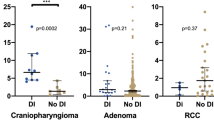Abstract
Diabetes insipidus (DI) after endoscopic transsphenoidal surgery (ETSS) can lead to increased morbidity, longer hospital stays, and increased medication requirements. Predicting which patients are at high risk for developing DI can help direct services to ensure adequate care and follow-up. The objective of this study was to review our institution’s experience with ETSS and determine which clinical/laboratory variables are associated with DI in this patient population. The authors wanted to see if there was an easily determined single value that would help predict which patients develop DI. This represents the largest North American series of this type. We retrospectively reviewed the charts of patients who had undergone ETSS for resection of sellar and parasellar pathology between 2006 and 2011. We examined patient and tumor characteristics and their relationship to postoperative DI. Out of 172 endoscopic transsphenoidal surgeries, there were 15 cases of transient DI (8.7 %) and 14 cases of permanent DI (8.1 %). Statistically significant predictors of postoperative DI (p < 0.05) included tumor volume and histopathology (Rathke’s cleft cyst and craniopharyngioma). Significant indicators of development of DI were postoperative serum sodium, preoperative to postoperative change in sodium level, and urine output prior to administration of 1-deamino-8-d-arginine vasopressin. An increase in serum sodium of ≥2.5 mmol/L is a positive marker of development of DI with 80 % specificity, and a postoperative serum sodium of ≥145 mmol/L is a positive indicator with 98 % specificity. Identifying perioperative risk factors and objective indicators of DI after ETSS will help physicians care for patients postoperatively. In this large series, we demonstrated that there were multiple perioperative risk factors for the development of DI. These findings, which are consistent with other reports from microscopic surgical series, will help identify patients at risk for diabetes insipidus, aid in planning treatment algorithms, and increase vigilance in high risk patients.
Similar content being viewed by others
References
Sheehan JM, Sheehan JP, Douds GL, Page RB (2006) DDAVP use in patients undergoing transsphenoidal surgery for pituitary adenomas. Acta Neurochir (Wien) 148(3):287–291
Makaryus AN, McFarlane SI (2006) Diabetes insipidus: diagnosis and treatment of a complex disease. Cleve Clin J Med 73(1):65–71
Bajpai A, Kabra M, Menon PS (2008) Central diabetes insipidus: clinical profile and factors indicating organic etiology in children. Indian Pediatr 45(6):463–468
Seckl J, Dunger D (1989) Postoperative diabetes insipidus. BMJ 298(6665):2–3
Olson BR, Gumowski J, Rubino D, Oldfield EH (1997) Pathophysiology of hyponatremia after transsphenoidal pituitary surgery. J Neurosurg 87(4):499–507
Jho HD (2001) Endoscopic transsphenoidal surgery. J Neurooncol 54(2):187–195
Kristof RA, Rother M, Neuloh G, Klingmüller D (2009) Incidence, clinical manifestations, and course of water and electrolyte metabolism disturbances following transsphenoidal pituitary adenoma surgery: a prospective observational study. J Neurosurg 111(3):555–562
Rajaratnam S, Seshadri MS, Chandy MJ, Rajshekhar V (2003) Hydrocortisone dose and postoperative diabetes insipidus in patients undergoing transsphenoidal pituitary surgery: a prospective randomized controlled study. Br J Neurosurg 17(5):437–442
Dumont AS, Nemergut EC, Jane JA Jr, Laws ER Jr (2005) Postoperative care following pituitary surgery. J Intensive Care Med 20(3):127–140
Fisher C, Ingram WR (1936) The effect of interruption of the supraoptico-hypophyseal tracts on the antidiuretic, pressor and oxytocic activity of the posterior lobe of the hypophysis. Endocrinology 20:762–768
Hensen J, Henig A, Fahlbusch R, Meyer M, Boehnert M, Buchfelder M (1999) Prevalence, predictors and patterns of postoperative polyuria and hyponatraemia in the immediate course after transsphenoidal surgery for pituitary adenomas. Clin Endocrinol (Oxf) 50(4):431–439
Nemergut EC, Zuo Z, Jane JA Jr, Laws ER Jr (2005) Predictors of diabetes insipidus after transsphenoidal surgery: a review of 881 patients. J Neurosurg 103(3):448–454
Sigounas D, Sharpless J, Cheng D, Johnson T, Senior B, Ewend M (2008) Predictors and incidence of central diabetes insipidus after endoscopic pituitary surgery. Neurosurgery 62(1):71–78
Zimmerman EA, Robinson AG (1976) Hypothalamic neurons secreting vasopressin and neurophysin. Kidney Int 10(1):12–24
Cheetham T, Baylis PH (2002) Diabetes insipidus in children: pathophysiology, diagnosis and management. Paediatr Drugs 4(12):785–796
Robertson GL, Shelton RL, Athar S (1976) The osmoregulation of vasopressin. Kidney Int 10(1):25–37
Black PM, Zervas NT, Candia GL (1987) Incidence and management of complications of transsphenoidal operation for pituitary adenomas. Neurosurgery 20(6):920–924
Dehdashti AR, Ganna A, Karabatsou K, Gentili F (2008) Pure endoscopic endonasal approach for pituitary adenomas: early surgical results in 200 patients and comparison with previous microsurgical series. Neurosurgery 62(5):1006–1015
Graham S, Iseli T, Karnell L, Clinger J, Hitchon P, Greenlee J (2009) Endoscopic approach for pituitary surgery improves rhinologic outcomes. Ann Otol Rhinol Laryngol 118(9):630–635
Schreckinger M, Szerlip N, Mittal S (2012) Diabetes insipidus following resection of pituitary tumors. Clin Neurol Neurosurg (Epub ahead of print)
Chen L, White WL, Spetzler RF, Xu B (2011) A prospective study of nonfunctioning pituitary adenomas: presentation, management, and clinical outcome. J Neurooncol 102(1):129–138
Hofstetter CP, Nanaszko MJ, Mubita LL, Tsiouris J, Anand VK, Schwartz TH (2011) Volumetric classification of pituitary macroadenomas predicts outcome and morbidity following endoscopic endonasal transsphenoidal surgery. Pituitary (Epub ahead of print)
Zada G, Cavallo L, Esposito F, Fernandez-Jimenez J, Tasiou A, De Angelis M, Cafiero T, Cappabianca P, Laws E (2010) Transsphenoidal surgery in patients with acromegaly: operative strategies for overcoming technically challenging anatomical variations. Neurosurg Focus 29(4):E8
Duff J, Meyer FB, Ilstrup DM, Laws ER Jr, Schleck CD, Scheithauer BW (2000) Long-term outcomes for surgically resected craniopharyngiomas. Neurosurgery 46(2):291–302 discussion 302–295
Honegger J, Buchfelder M, Fahlbusch R (1999) Surgical treatment of craniopharyngiomas: endocrinological results. J Neurosurg 90(2):251–257. doi:10.3171/jns.1999.90.2.0251
Lehrnbecher T, Muller-Scholden J, Danhauser-Leistner I, Sorensen N, von Stockhausen HB (1998) Perioperative fluid and electrolyte management in children undergoing surgery for craniopharyngioma. A 10-year experience in a single institution. Childs Nerv Syst 14(6):276–279
Conflict of interest
The authors declare that they have no conflicts of interest.
Author information
Authors and Affiliations
Corresponding author
Rights and permissions
About this article
Cite this article
Schreckinger, M., Walker, B., Knepper, J. et al. Post-operative diabetes insipidus after endoscopic transsphenoidal surgery. Pituitary 16, 445–451 (2013). https://doi.org/10.1007/s11102-012-0453-1
Published:
Issue Date:
DOI: https://doi.org/10.1007/s11102-012-0453-1




